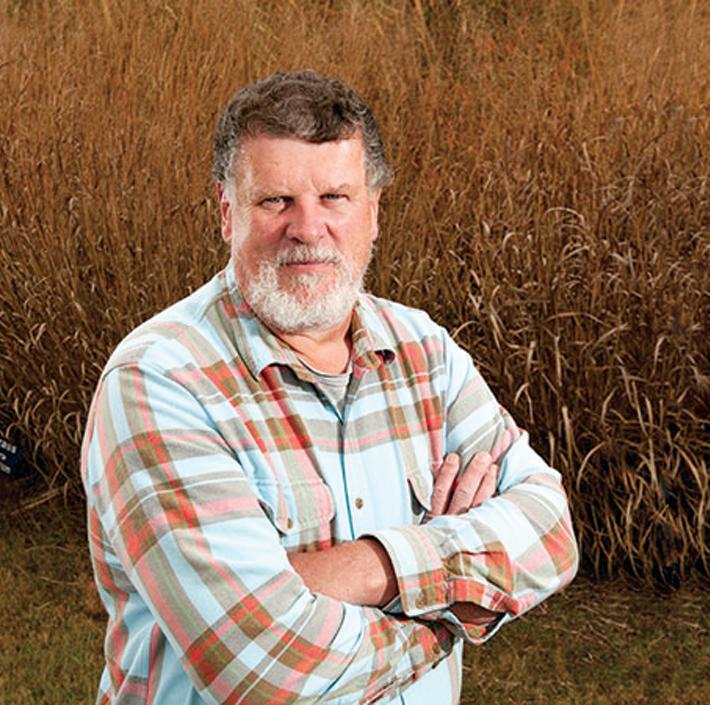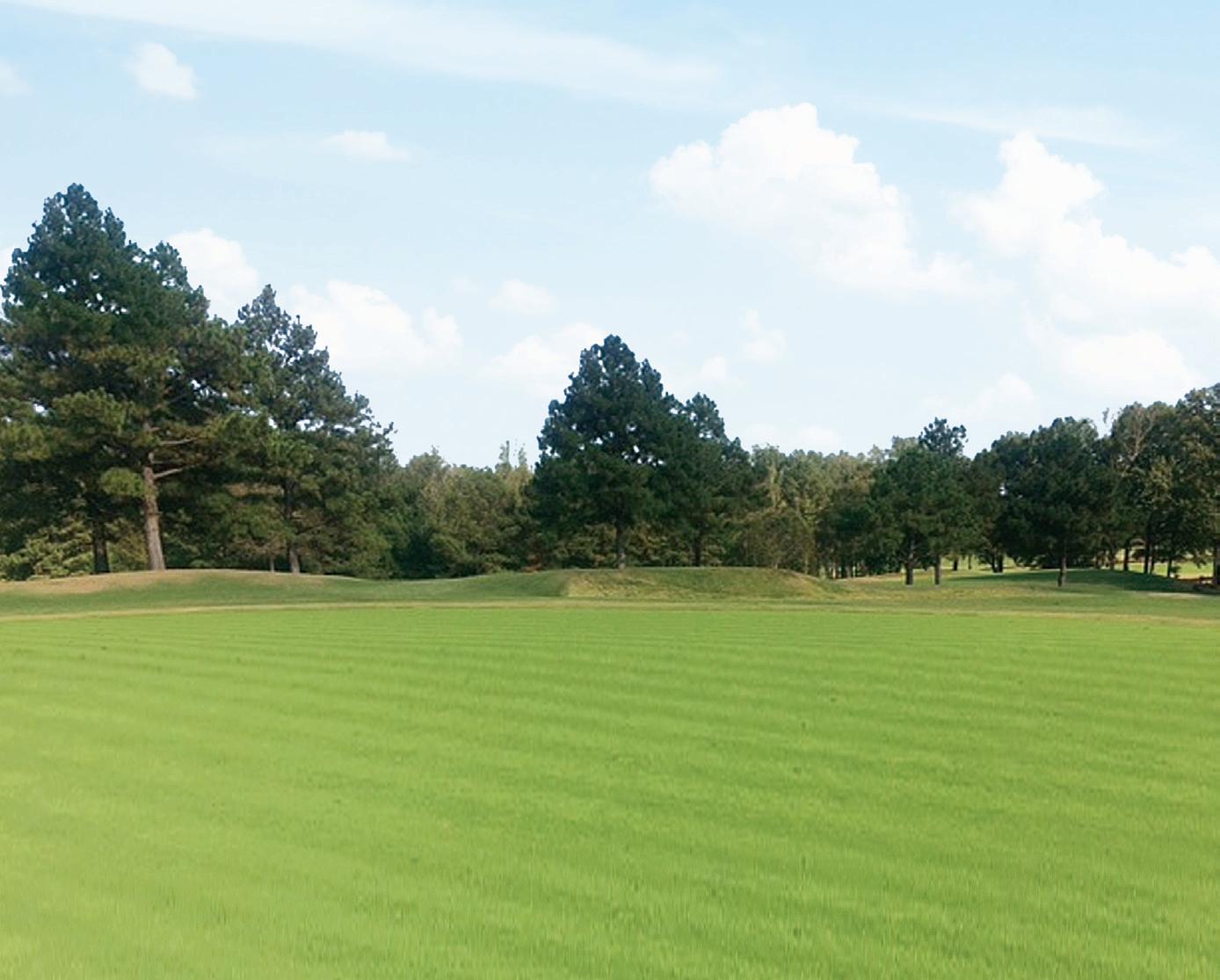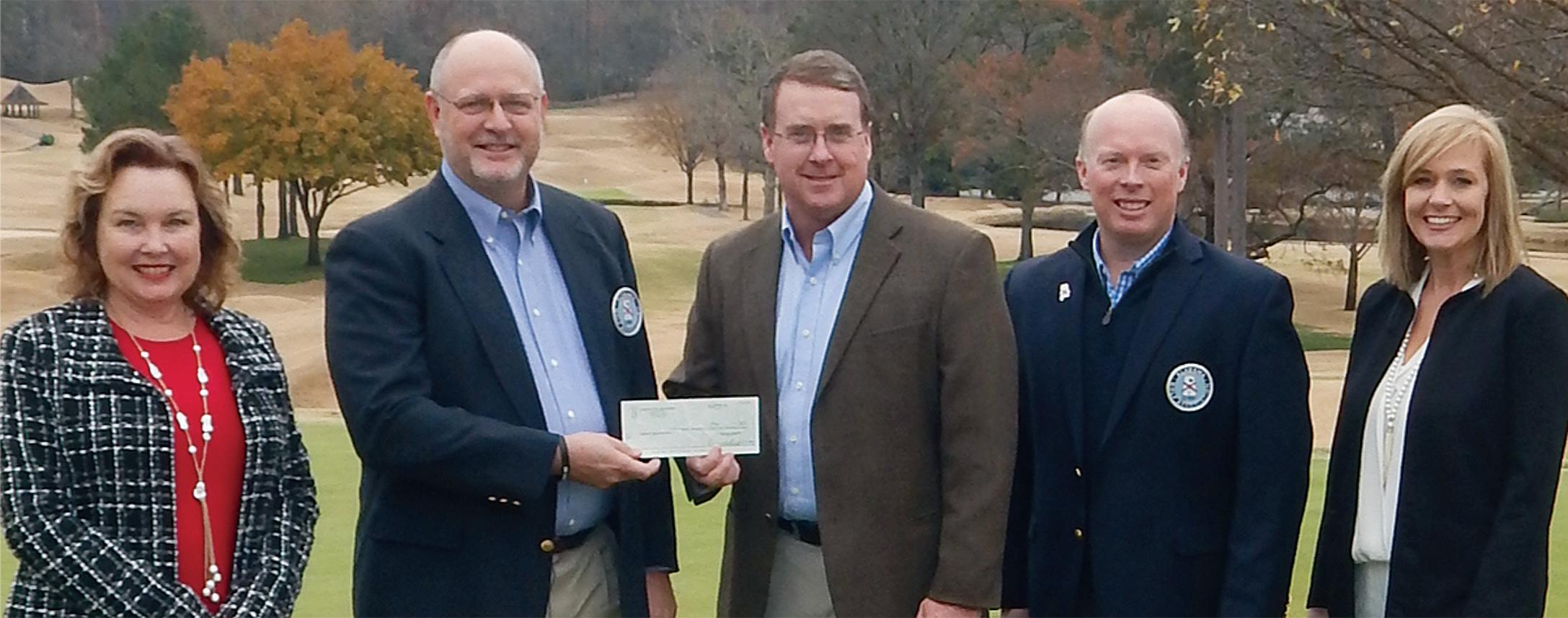
9 minute read
AU Victory: A Bent Grass Success Story
By Ian Thompson, originally published in Thompson Tees Off
I have two children who attend Auburn University, but their choice of college has no bearing on this story. It is a nice side-note though, that when I told them about AU Victory, they both at first thought I was talking about the football team’s latest W!
Advertisement
No, this is a victory for golf courses in the heat of the south desiring to use bent grass on their putting surfaces. It has been a true success story on the greens at the aptly-named Bent Brook, a course of 30 years, which stands adjacent to I-459 near Bessemer, along with recent converts Shoal Creek, Vestavia CC and others across the state and further afield.
If the words “a truly heat-tolerant bent grass” seem a contraction, AU Victory is here to prove doubters wrong.

Long-time Country Club of Birmingham head superintendent Lee McLemore is a highly respected voice in golf course conditioning and maintenance.
Before I impart the in-depth thoughts of long-time Bent Brook superintendent Johnny Perry, along with Lee McLemore, AU graduate and course superintendent since 1987 over both courses and the always immaculate grounds at The Country Club of Birmingham, allow me to visit a story written about the advent of this resilient strain of bent grass, published three years ago by Auburn University’s agriculture department, but still highly relevant today...

Long-time Bent Brook golf course superintendent Johnny Perry has seen great results with AU Victory bent grass.
The story of AU Victory as told by Auburn University’s agriculture department
The new variety — the first bent grass released by the university’s turfgrass research team — could be the perfect solution for golf course superintendents looking for a bent grass putting surface that will thrive in the high humidity and heat that characterizes many areas where such putting greens are featured.
Edzard van Santen, a professor in the Department of Crop, Soil and Environmental Sciences who specializes in plant breeding and genetics, said AU Victory is a survivor of collections made from putting greens during prolonged summer droughts. He describes his approach to developing AU Victory as part “tough love” and part “survival of the fittest.”

Dr. Edzard van Santen has led the research and development of AU Victory bent grass.
“In Alabama, bent grass is grown mostly in the northern third of the state, but some golf courses don’t have their own water sources, relying instead on municipal water systems,” van Santen said. “When weather conditions turned dry during the summers of 1999 and 2000, some cities cut off the golf courses’ water supplies to help conserve water. As a result, some of the greens couldn’t be watered.”
Seeing an opportunity, van Santen salvaged surviving plugs from otherwise decimated greens. Approximately 300 individual plugs were collected, grown in a greenhouse and transplanted to a field at Auburn University’s Tennessee Valley Research and Extension Center in Belle Mina. That’s when a two-year period of tough love began.
“I asked the folks in north Alabama to mow them occasionally but to otherwise forget about them. If they don’t survive, then that’ll be the end of the project.”
But some — about half of them — did survive, so van Santen initiated a collaborative effort with Virginia Lehman, a private turfgrass breeder in Oregon. She eliminated 50 of the entries based on appearance and turf quality.
“Seed production for cool-season grasses such as bent grass must occur in Oregon or a similar climate,” van Santen said. “We can’t produce the seed here because the weather’s too hot, and the seed matures too late. Oregon has nice, mild winters, and the grass lives on residual soil moisture during the summer due to a lack of rainfall, resulting in excellent seed quality.”
Seed harvested from the 100 remaining entries was used to establish plots at Auburn, plots that were rated for color, turf quality and disease tolerance.
“In late May of 2004, we began withholding all fungicide applications from the evaluation trial, and we minimized supplemental irrigation. Very little disease was noted throughout the summer, but in October of 2004, a severe dollar-spot infestation occurred, allowing us to distinguish our entries from commercial comparisons.”
Plugs from selected entries then were sent to Oregon to establish breeder-seed nurseries, which were harvested for seed in 2005 and 2006. Beginning in fall 2005, these two experimental populations were tested in various trials at Auburn and used on nursery greens at the Country Club of Birmingham and at Grand National in Opelika.
In consultation with industry professionals, van Santen chose one experimental population for advancement, and a foundation seed field was established in Oregon in fall 2009. Foundation seed was harvested in 2010 and 2011, and commercial seed multiplication was initiated in 2014.
AU Victory already has proven to be a hit in Alabama, where it has been used to renovate the greens at Southern Gayles Golf Course in Athens. The Deer Run Golf Course in Moulton has nine greens seeded to AU Victory after it provided the solution for a problem green there. In addition, Bent Brook Golf Course in Birmingham is in the process of renovating all 27 greens with AU Victory.
“Bent grass is desirable for golfers because it helps the ball run true and fast, but managing it can be a challenge,” van Santen said. “The big difference we see in AU Victory compared to other bent grass varieties is root mass. It has many more roots, and they are deeper than in other cultivars. That’s the direct result of tough selection for drought resistance.
“The other advantage is that it has a higher shoot density,” he said. “That’s not unique, because all modern varieties that have come out of other breeding programs share that characteristic. If you have adequate bent grass shoot density, you have fewer weed problems.”
Other favorable characteristics of AU Victory include quick establishment, even at low seeding rates, and good color and turf quality during late-summer stress periods. It also has shown the ability to recover quickly following aeration.
Van Santen says he and other researchers are already working on the second and third generations of AU Victory.
“Plant breeding is a trans-generational enterprise,” he said. “We’re not striving for perfection, but incremental improvements.”
AU Victory is marketed through the Alabama Crop Improvement Association in Headland.
Funding for this research was partially provided by the Alabama Turfgrass Research Foundation. Also, the Alabama Golf Association believes strongly in improving the surface the game is played on and is a major partner of the ATRF.
Fast forward to the current day...
Bent Brook did indeed rebuild all 27 of their greens and Perry is a strong believer in AU Victory. After all, he sees the proof every day.
“In 2010 we’d had some issues with our greens. It was time to start looking at what was out there. We reseeded one of our practice putting greens in thirds of A1, L93 and AU Victory bent grasses. The AU Victory was always the last to be watered and looked after, but it still thrived. I was intrigued.”
In conversations with Jimmy Lee III, the visionary owner of Bent Brook, Perry became more and more convinced AU Victory was the way to go. “Having Mr. Lee’s trust, commitment and vision for the course has allowed us to have the success we have had,” Perry noted. “He has always backed me in my decisions and did so again this time.”
Having 27 holes, they could close a nine and leave the other two open. First to get the new greens was the Graveyard nine in summer 2014, reopening the following May. That fall it was the turn of the Windmill nine to close, but it was a lot quicker reopening that December as Perry and his team became more comfortable with the new grass.
Finally, the Brook closed in early 2016, reopening that June.

The first green on the Windmill nine at Bent Brook 20 days after seeding with AU Victory.
“I was unsure about opening them that summer. We’d had a significant tornado in February that did a lot of damage and I wasn’t certain the new greens were ready for the heat and humidity. Sure, they had some limited stress, but always bounced back stronger than before. We had a lot of play and it was a real eye opener how well they did.”
Owen Coulson and Rex Davis, the course superintendents at Vestavia CC and Shoal Creek respectively, came to visit in the heat of August 2016. What Perry showed them convinced them both that AU Victory was the right grass for their ongoing course renovations.
“I pulled a plug from one of the greens and the root structure was nine to 10 inches long! It blew their minds how healthy these new greens were.”

A very healthy AU Victory root sample taken at Bent Brook during hot summer conditions.
The following June, Bent Brook hosted the State Amateur, the Alabama Golf Association’s top championship.
“We double cut and rolled the greens and they were firm, fast (12 on the Stimpmeter) and, most importantly, healthy. I heard many positive comments from the players and the AGA.”

Left to Right: Melanie Bonds (Alabama Golf Course Superintendents Association, Alabama Turfgrass Association), Derrell Curry (Alabama Golf Association), Lee McLemore, CGCS (Alabama Turfgrass Research Foundation), Andy Priest (Alabama Golf Association), and Tricia Roberts (Alabama Turfgrass Research Foundation). The AGA presented the Alabama Turfgrass Research Foundation a check for $11,435 toward ongoing research.
Perry noted that while, of course, he and his team keep a close eye on the greens in the summer, he does not stress over them.
“It has enabled us to focus on other course projects instead of having to have so much of our manpower devoted to the greens.”
Perry has a deep love for and knowledge of Bent Brook. He started out as original course superintendent Todd Sloan’s assistant, before taking on the head role in 1999.
“I think it is very cool (pardon the pun) that AU Victory does so well in the Alabama summer climate while it has been installed at three Birminghamarea courses with three very different micro-climates: the elevation of Vestavia; the wide open countryside of Bent Brook; and within the valley of Oak Mountain and Double Oak Mountain at Shoal Creek.”
McLemore, while not having AU Victory on the greens on either the East or West Courses at the Country Club of Birmingham, has also seen firsthand the success of this bent grass.
“We planted the first test plots on a nursery green in 2005. The AU Victory plots would look similar to the other bent grass plots for most of the year. However, when conditions would get nasty (high heat and humidity, little to no water), AU Victory always stood out.”
McLemore said AU Victory consistently out-performed the other bent grasses for three years.
“When it came time to redo the greens on the West in 2008, I wanted to use AU Victory, but the seed wasn’t ready to release. We ended up using an A1/A4 mix, which I have been pleased with.
“I must say that AU Victory puts up with ‘tough love’ better than any other bent grass I’ve experienced. Little to no disease and superb heat tolerance is a great combination.”
What does the future hold?
AU Victory II is in the works and grass seed development is always an ongoing process. You can be sure many, many courses in the south desiring bent grasses greens will be following its progress with keen interest.







